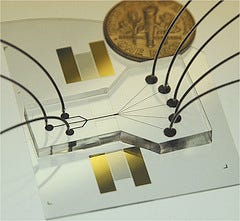October 10, 2012
|
Cell-sorting technology can separate cells into several channels, allowing more cell types to be analyzed simultaneously. |
Using two beams of acoustic waves to act as tweezers, researchers at Penn State University (University Park) have developed a new technology that can sort cells into five or more channels. The technique, according to Tony Jun Huang, associate professor of engineering science and mechanics, can easily alter the paths of the cells, allowing more cell types to be analyzed simultaneously and paving the way for smaller, more-efficient, less-expensive analytic medical devices. For example, biological, genetic, or medical labs could eventually employ the device for performing a range of analyses, such as blood and genetic testing.
"Eventually, you could do analysis on a device about the size of a cell phone," said Huang. "It's very doable and we're making inroads to that right now."
Most current devices sort cells into only two channels in one step, Huang explains. Furthermore, in these technologies, cells must be encapsulated into droplets, complicating further analysis. In addition, current methods produce aerosols--gases that require extra safety precautions.
The researchers use a silicone material called polydimethylsiloxane to produce the chip. First, two parallel transducers for converting alternating current into acoustic waves are placed at the sides of the chip. As the acoustic waves interfere with each other, they form pressure nodes on the chip. When cells cross the chip, they are channeled toward these pressure nodes. The transducers are tunable, enabling researchers to adjust the frequencies and create pressure nodes on the chip.
The researchers tested the device by sorting a stream of fluorescent polystyrene beads into three channels. Before turning on the transducer, the particles flowed across the chip unimpeded. Once the transducer produced the acoustic waves, the particles separated into the channels. Following this experiment, the researchers sorted human white blood cells affected by leukemia. The leukemia cells were first focused into the main channel and then separated into five channels.
The device is not limited to five channels, Huang says. "We can do more. We could do 10 channels if we want, we just used five because we thought it was impressive enough to show that the concept worked."
About the Author(s)
You May Also Like



